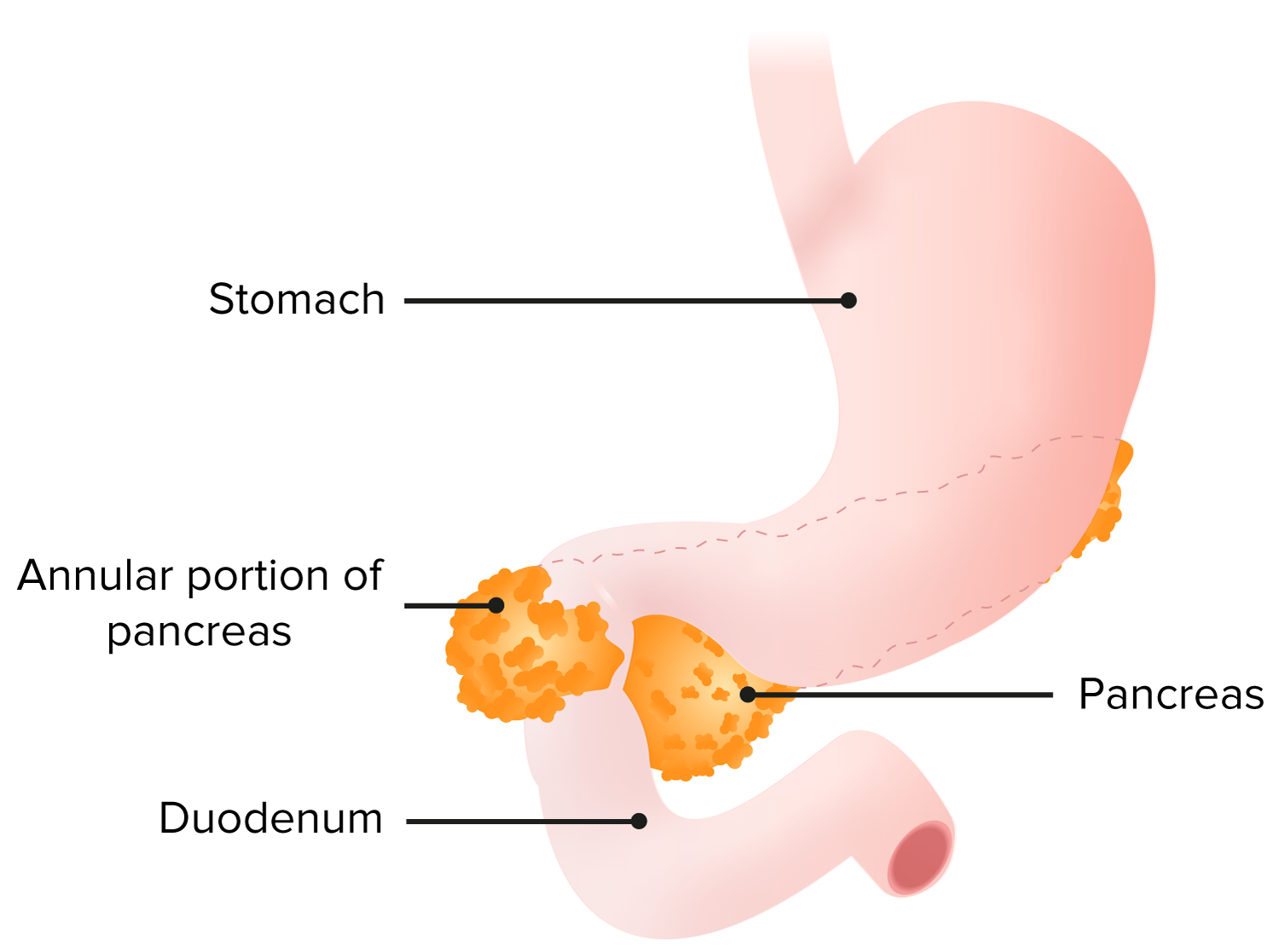Playlist
Show Playlist
Hide Playlist
Pediatric Duodenal Atresia
-
Slides GD Pediatric GI.pdf
-
Download Lecture Overview
00:01 Here, we’ll take a look at duodenal atresia. 00:05 So what does atresia mean to you? In pathology and embryology, atresia means lack of development. 00:12 You’ve heard of esophageal atresia. 00:13 You’ve heard of tricuspid atresia. 00:15 You’ve heard of biliary atresia And here we have duodenal atresia. 00:19 What’s the definition? Duodenal atresia is obstruction. 00:24 Obstruction, why? Failure to recanalize the duodenal lumen. 00:29 Now, what does this mean to you? And when does this occur? Did this occur after birth or before delivery? Obviously before delivery, this is a congenital issue. 00:41 I want you to go back into the womb of the mother. 00:43 We do that quite a bit in pathology, don’t we? So there you are in the womb of the mother and you’re lying in the maternal placenta. 00:52 The duodenum fails to recanalize. 00:55 Simple amniotic fluid circulation for pathology that would help you answer any question dealing with what's known as as amnios or hydramnios? Let’s talk about this one, the duodenum in the uterus is not properly formed, the fetus. 01:13 And so now at this point, what the fetus is doing is regurgitating the amniotic fluid into the placenta. 01:20 If you’re regurgitating the amniotic fluid into the placenta, there’s excess fluid in the placenta. 01:26 How are you as a clinician going to then identify the excess fluid? You do an ultrasound on the pregnant lady and you’re going to find increased amounts of amniotic fluid. 01:35 We call this what? Polyhydramnios. 01:39 Have you set up a picture yet? Next, as the child is delivered and at some point when the child starts feeding, then what may then happen? Once again, there’s an obstruction. 01:52 Now where is the obstruction? I’ll explain this to you and then I’ll show you a picture of an abdominal x-ray. 02:00 The stomach is not going to connect with the duodenum. 02:04 Duodenal atresia. 02:06 And by the time it does, you might have bile connect to your second part of the duodenum. 02:13 And so therefore, with consumption of food, the vomit that the child is going to have is filled with bile. 02:20 So therefore you call this, bilious vomiting. 02:22 Next, if you can’t get past the obstruction, duodenal atresia, you’re going to have a gas bubble there on x-ray and if you do not recanalize on the other side, you’ll also find a gas bubble, so therefore duodenal atresia would be something called double bubble sign that’s to come. 02:42 Let’s begin. 02:44 Risk factors here big time is another D. 02:48 So with duodenal atresia, you can use the letter D to advantage. 02:51 It’s duodenal atresia. 02:53 It’s Down syndrome. 02:55 Welcome to Trisomy 21. 02:57 D – Duodenal. D – Down’s, and here, most likely, the vomit here will be bilious. 03:04 What does that mean to you? How are they going to describe this is a stem of a question? They’ll say it’s greenish yellow that’s what color bile is, versus let's say that the esophagus didn’t form properly. 03:16 Esophageal atresia. 03:18 The child is going to live, so there’s no failure to thrive, and during that type of regurg, it is -- Right? It’s really cute actually, and the vomit is non-bilious because the esophagus doesn’t form properly. 03:33 Or we’ll talk about this later on if the pylorus undergoes hypertrophy, that is much more proximal than to the connection of the bile, correct? Here, with pyloric stenosis, you can experience vomit that will be -- or the child will experience it being projectile. 03:51 It will come in right at you, but it will be non-bilious. 03:54 Two types, now bilious is a big deal. 03:59 In a child, if it’s bilious vomiting, it is an emergency. 04:05 I’ll tell you why because the differentials become much more serious here. 04:08 Maybe you might have something like your necrotizing enterocolitis. 04:13 There might be volvulus. 04:15 In this case, there’s duodenal atresia, Not so much an emergency here per se, but as far as you’re concerned on your boards and on the wards, bilious vomiting in a child, whew, emergency. 04:27 Now, bilious vomiting is found on the first day. 04:29 Usually no abdominal distention. 04:32 No abdominal distention. 04:34 And remember, in utero, what’s the fetus doing? Vomiting. 04:40 Vomiting what? Amniotic fluid. 04:42 Think of it as such because then it will be easy for you to identify polyhydramnios. 04:48 No such thing as Potter sequence here. 04:50 This is polyhydramnios, lot of amniotic fluid. 04:54 Let’s go ahead and take a look at that abdominal x-ray. 04:56 Take a minute to look at your areas here in the abdomen and you'll find two areas that are black or lucent, right? So the two areas of lucency that you find on abdominal x-ray will be two different organs that have now accumulated gas. 05:14 One will be the stomach, the other one would be the failure of recanalization of the duodenum that will be the side of the duodenum. 05:22 This then gives you the double bubble sign. 05:25 This then completes our third D in duodenal atresia. 05:28 Duodenal atresia, Down’s syndrome, double bubble sign. 05:35 Management here, with atresia, it’s surgery. 05:38 Pretty straightforward. 05:39 What kind? Not necessary. 05:42 If you want to know more, by all means, please do so. 05:46 And those of that will go into surgery as residents, then obviously you’d find this to be quite interesting.
About the Lecture
The lecture Pediatric Duodenal Atresia by Carlo Raj, MD is from the course Pediatric GI Pathology.
Included Quiz Questions
Which of the following is associated with duodenal atresia?
- Polyhydramnios
- Oligohydramnios
- Hyperemesis
- Meconium aspiration
- Status of small for gestational age
Which chromosomal abnormality is associated with duodenal atresia?
- Down's syndrome
- Patau syndrome
- Edwards syndrome
- Klinefelter syndrome
- Turner's syndrome
Which of the following is NOT a cause of bilious vomiting in a child?
- Esophageal atresia
- Duodenal atresia
- Necrotizing enterocolitis
- Volvulus
- Hirschsprung disease
Which radiological sign may be seen in patients with duodenal atresia?
- Double bubble sign
- Target sign
- Rat tail sign
- Multiple air shadows
- Snowstorm sign
What kind of vomiting is expected in a child with duodenal atresia?
- Bilious vomiting
- Non-bilious vomiting
- Short bouts of vomiting immediately after feeding
- Projectile type of vomiting
- Blood mixed in vomiting
Customer reviews
5,0 of 5 stars
| 5 Stars |
|
5 |
| 4 Stars |
|
0 |
| 3 Stars |
|
0 |
| 2 Stars |
|
0 |
| 1 Star |
|
0 |




